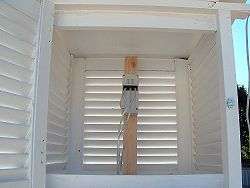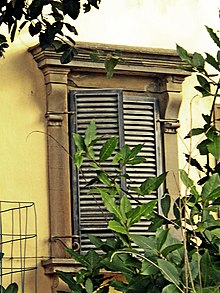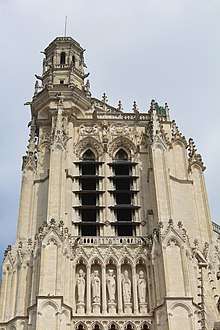Louver
A louver (American English) or louvre (British English; see spelling differences) is a window blind or shutter with horizontal slats that are angled to admit light and air, but to keep out rain and direct sunshine. The angle of the slats may be adjustable, usually in blinds and windows, or fixed.[1]
.png)



History
Louvers originated in the Middle Ages as lantern-like constructions in wood that were fitted on top of roof holes in large kitchens to allow ventilation while keeping out rain and snow. They were originally rather crude constructions consisting merely of a barrel. Later they evolved into more elaborate designs made of pottery, taking the shape of faces where the smoke and steam from cooking would pour out through the eyes and mouth, or into constructions that were more like modern louvers, with slats that could be opened or closed by pulling on a string.[2]
Construction
Modern louvers are often made of aluminum, metal, wood, or glass. They may be opened and closed with a metal lever, pulleys, or through motorized operators.[3] The Standard specifies requirements for the construction of buildings using louver in bushfire-prone areas in order to improve their resistance to bushfire attack from burning embers, radiant heat, flame contact and combinations of the three attack forms.[4] The revised building standard details various construction methods and materials that must be used depending on the homes level of bushfire risk. This includes changes to the window and glazing requirements for homes located in a Bushfire Attack Level category greater BAL-Low.
Jalousies
Often used interchangeably by mistake, the key difference between louvers and jalousies is that louvers are fixed position. Jalousies are installed within a movable adjustable mechanism which positions all jalousies into any parallel position with respect to each other.[5]
Use
In architecture

Louvers are rarely seen as primary design elements in the language of modern architecture, but rather simply a technical device. Louvers are part of the design of Demerara windows to help keep 18th and 19th century buildings cool in hot climates and block direct sunlight.[6][7] Some modern louver systems serve to improve indoor daylighting. Fixed mirrored louver systems can limit glare and of redirect diffuse light. Such louvers may be integrated in between two panes of double glazing.[8] In industrial facilities such as steel foundries and power plants, louvers are very common. They are utilized for natural ventilation and temperature control.
Louvers are frequently found in bell towers, where they are utilised to let out as much sound as possible, while having the bells remain unexposed to the weather.
In infrastructure
Louvers may be used as a type of flood opening, usually covered by one or more moving flaps. They are designed to allow floodwaters to enter and leave the building, equalizing hydrostatic pressure on the walls and mitigating structural damage due to flooding. Louver windows are a staple in the design of homes and perfect to withstand the pressures of future cyclonic conditions. [9] Cyclone homes have always been synonymous with louver windows, louver blades have been tested for ‘debris type B’ for cyclonic regions.
In transportation
Louvers are used as semi-passive means of thermal control on spacecraft as well.[10]
Rear window louvers are also available as an accessory for some automobiles.
Louvers may also be used on traffic light lenses to prevent traffic from seeing the wrong traffic signal.
In Electronics
Louvers are used for different purposes in electronics.
For ventilation purposes
Based on the design of the electronic device, a majority of the electronic devices that have them are laptops. They are less likely seen in desktops, where the design of the airflow vents are usually circular holes.
The majority of laptops that use louvers are workstation[11] or gaming[12] laptops, where there is a higher need of air flow, than other laptops. The louvers are usually situated near the internal fans. Majority of the time, laptop manufacturers call these louvers "fan louvers".[13]
Examples
There are examples of architects who use louvers as part of the overall aesthetic effect of their buildings. The most well-known example is Finnish modernist architect Alvar Aalto who would create aesthetic effects in the facades of his buildings through the combination of different types and sizes of louvers, some fixed some moveable, and made mostly from wood (e.g., the various buildings of the Helsinki University of Technology). A second example, taking influence from Aalto, is the second-generation modernist architect Juha Leiviskä.
See also
| Look up louver in Wiktionary, the free dictionary. |
References
| Wikimedia Commons has media related to Louvers. |
- Notes
- "Definition from "The Free Dictionary"". Retrieved 2 March 2014.
- Henisch (1976), pp. 96–97.
- "Louver from "Encyclopædia Britannica"". Encyclopædia Britannica. Archived from the original on 10 August 2014. Retrieved 2 March 2014.
- "Specifying Louvres in Bushfire Prone Areas". SafetyLine Jalousie. 18 September 2018. Retrieved 18 September 2018.
- Architectural Terms & Definitions Textbook
- Rory, Westmas (31 May 2010). "Architecture - Building Under the Sun". Stabroek News. Retrieved 2 June 2018.
- Haley, Murtland (23 April 2017). "The Demerara Window – the Colonial 'AC'". Kaieteur News. Retrieved 2 June 2018.
- Dariusz Heim and Kamil Kieszkowski: Shading Devices Designed to Achieve the Desired Quality of Internal Daylight Environment Archived 7 June 2011 at the Wayback Machine, PLEA2006 - The 23rd Conference on Passive and Low Energy Architecture, Geneva, Switzerland, 6–8 September 2006
- "A Timely Reminder Why Louvre Windows Were Specified in Queensland Cyclone Shelters". SafetyLine Jalousie. 29 March 2017. Retrieved 29 March 2017.
- "Archived copy". Archived from the original on 9 July 2014. Retrieved 24 May 2014.CS1 maint: archived copy as title (link) "The system devised for Rosetta employs several new techniques, including the installation of louvres over the radiators, to keep spacecraft hardware at proper operating temperatures"
- Lenovo. “Computer Controls, Connectors, and Indicators.” P52 User Guide, by Lenovo, 2nd ed., pp. 21–23, download.lenovo.com/pccbbs/mobiles_pdf/p52_ug_en.pdf
- Lenovo. “Computer Controls, Connectors, and Indicators.” T580 And P52s User Guide, edited by Lenovo, 4th ed., Lenovo, pp. 19–22, download.lenovo.com/pccbbs/mobiles_pdf/t580_p52s_ug_en.pdf
- Lenovo. “Computer Controls, Connectors, and Indicators.” E480 And R480 User Guide, edited by Lenovo, 4th ed., Lenovo, pp. 20–20, download.lenovo.com/pccbbs/mobiles_pdf/e480_r480_ug_en.pdf
- Bibliography
- Henisch, Bridget Ann Fast and Feast: Food in Medieval Society. The Pennsylvania State Press, University Park. 1976. ISBN 0-271-01230-7
- "Foundation Flood Vents". National Association of Home Builders (NAHB) Research Center. 2001. https://web.archive.org/web/20130116013400/http://toolbase.org/about.aspx.